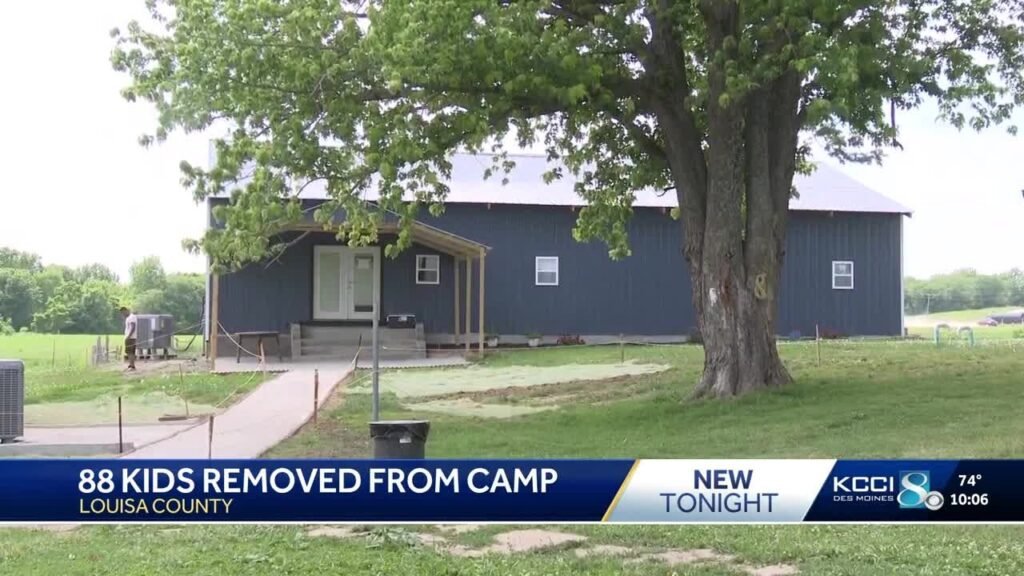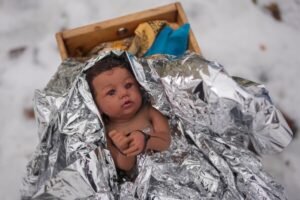Breaking the Silence: 88 Children Removed from Iowa Bible Study Camp in Human Trafficking Sting

88 Children Removed from Iowa Bible Study Camp
Introduction
Recently, a significant incident unfolded in Iowa, where 88 children were removed from a Bible study camp as part of a coordinated human trafficking sting operation. This alarming event has highlighted the vulnerabilities faced by young individuals in seemingly safe environments and has raised critical questions about the preventative measures in place to protect minors from exploitation.
The operation was spearheaded by local law enforcement officials, in collaboration with federal agencies, who were alerted to suspicious activities at the camp. Reports suggested irregularities in the camp’s administration and potential abuse of minors, prompting a thorough investigation. By the time the sting was conducted, authorities had gathered sufficient evidence to act decisively, leading to the intervention that resulted in the large-scale removal of children.
This incident has drawn widespread media attention and sparked conversations around child safety, the role of community organizations, and the potential threats that exist even in religious and educational settings. Organizations dedicated to child protection have emphasized the need for vigilance and proper oversight in such gatherings, asserting that the responsibility lies not only with law enforcement but also with community members to ensure the well-being of children.
The purpose of this blog post is to provide a comprehensive overview of the Iowa incident, discussing its implications for child safety and the ongoing fight against human trafficking. We aim to shed light on the steps taken by authorities, the reactions from the involved parties, and how such events can serve as a wake-up call for communities across the nation. Understanding the complexities surrounding this issue is vital for fostering a proactive environment that prioritizes the safety and welfare of children.
Background on Human Trafficking
Human trafficking is a grave violation of human rights, defined as the unlawful trade of individuals for various forms of exploitation, including forced labor, sexual exploitation, and involuntary servitude. This heinous crime affects millions worldwide, with a significant portion of victims being children. According to the International Labour Organization, approximately 1.5 million children are currently victims of trafficking, making it a critical concern that demands our attention and action.
The forms of human trafficking that impact children are numerous and often intersect with other forms of abuse. Child sex trafficking is one of the most notorious forms, wherein minors are coerced or manipulated into engaging in commercial sex acts. Additionally, children can be trafficked for labor, placed in hazardous working conditions, or used as child soldiers in conflict zones. The psychological and physical ramifications for these young victims can be devastating, as they often experience long-term trauma and a lack of access to education and essential resources.
Statistics on human trafficking reveal a sobering reality; the Global Slavery Index estimates that approximately 40 million people are victims of modern slavery, with a significant percentage involving children. In the United States, the National Human Trafficking Hotline recorded thousands of cases involving minors, highlighting the urgent need for vigilance and intervention. It is crucial to raise awareness about the indicators of human trafficking so communities can recognize and respond to potential cases.
Educational initiatives play a vital role in combatting this pervasive issue by informing youth, parents, and community leaders about the risks and signs of trafficking. Awareness campaigns can empower individuals to speak out and seek help, ultimately leading to the prevention of further exploitation. Only through collective efforts can we hope to create a society where children are safe from the threat of human trafficking.
Overview of the Iowa Bible Study Camp
The Iowa Bible Study Camp is a religious-centered facility that has served the local community for several years. Established with the aim of providing spiritual growth and moral education, the camp focuses on nurturing children’s faith, fostering community bonds, and instilling positive values among its attendees. The mission of the camp is to create a safe and nurturing environment where children can engage in Bible study, participate in group activities, and learn essential life skills, all while developing a deeper understanding of their faith.
The camp operates during the summer months, drawing in a diverse demographic of children, typically ranging from ages 8 to 16. Participants come from various backgrounds, including families that are actively involved in their local churches. The Iowa Bible Study Camp offers a wide array of activities, including arts and crafts, outdoor sports, nature hikes, and group games, all designed to encourage teamwork and cooperation. Each activity is rooted in biblical teachings and aims to reinforce the core values of compassion, integrity, and respect.
In addition to recreational activities, the camp integrates structured Bible study sessions led by trained counselors and volunteers. These sessions encourage children to explore biblical stories and applications in today’s world, fostering spiritual growth and critical thinking. The facility’s layout includes cozy cabins for overnight stays, communal dining areas, and various recreational facilities, creating a welcoming and engaging atmosphere. The overall environment is designed to provide not only spiritual enrichment but also emotional and social support, facilitating meaningful connections among peers.
Understanding the context and operations of the Iowa Bible Study Camp is crucial, as it highlights the significance of the recent sting operation aimed at uncovering human trafficking activities within this ostensibly safe space. By delving into the camp’s mission and demographic, readers can gain insight into the broader implications of the disturbing events that have transpired.
Law Enforcement Action
In a significant turn of events, law enforcement agencies executed a meticulously planned sting operation that led to the removal of 88 children from a Bible study camp in Iowa, revealing deep-seated issues related to human trafficking. The operation resulted from an extensive investigation where local and federal agencies collaborated to infiltrate and surveil the camp over several months. This collaboration aimed to gather intelligence regarding the suspected activities connected to the camp and the potential exploitation of minors.
The investigation commenced after local authorities received alarming reports from concerned citizens about unusual behaviors and circumstances surrounding the camp. Following these reports, a task force was assembled, comprising the local police department, the FBI, and other federal entities specializing in human trafficking. They utilized a combination of undercover operations and surveillance techniques to collect vital information, documenting patterns of behavior that indicated human trafficking operations.
As the operation progressed, investigators uncovered a network that facilitated the exploitation of minors, raising alarm bells across law enforcement. The culmination of this intelligence gathering led to a well-coordinated rescue operation. On the day of enforcement, officers executed a series of simultaneous raids on various locations associated with the camp, ensuring the children’s safety was prioritized. The operation was carried out with an overwhelming presence of law enforcement, reflecting the seriousness of the allegations and the need to protect vulnerable populations.
The outcome of the sting operation was significant, not just in the rescue of these children, but also in the subsequent arrests made, aiming to dismantle the organized networks involved in human trafficking. The collaboration between local and federal agencies exemplifies a proactive approach to combating this grave issue, demonstrating a commitment to eradicating human trafficking and ensuring the safety of children across the nation.
Public and Community Reactions
The shocking events surrounding the removal of 88 children from an Iowa Bible study camp have ignited intense public discourse and varied community reactions. Many parents have expressed feelings of alarm and betrayal, with some questioning the safety measures in place at such camps. Social media platforms have become arenas for debate, with users sharing their opinions, emotions, and personal experiences related to the alleged human trafficking operation. The hashtag associated with the incident has gained momentum, sparking conversations that extend beyond the immediate community.
Local leaders have also voiced their concerns, emphasizing the necessity of increased scrutiny on organizations that cater to children. Statements from municipal officials underline a collective commitment to ensuring the safety of minors and preventing such distressing situations in the future. Community forums have emerged, providing spaces for parents to engage with law enforcement and share their apprehensions about child safety in similar environments. Non-profit organizations focused on child welfare have issued press releases urging thorough investigations and heightened awareness regarding the vulnerability of children in various settings.
The media coverage has played a pivotal role in shaping public perception of the incident. Reports highlight not only the unfortunate circumstances but also the broader implications for community trust in educational and recreational programs. Anchors, analysts, and editorial writers have called for a reevaluation of regulations governing such camps to better protect children and prevent exploitation.
Amid this disconcerting reality, there are glimmers of hope as some community members have come together, advocating for change and accountability. They are participating in discussions aimed at creating a safer environment for children while fostering a culture of vigilance against human trafficking. This ongoing dialogue underscores a community’s resilience in confronting such challenges and striving for a secure future.
The Aftermath: Support for the Children
The recent operation that removed 88 children from an Iowa Bible study camp has drawn significant attention to the importance of adequate support and resources in the aftermath of such incidents. Immediate intervention has been enacted by social services and various child welfare organizations, which are essential in addressing the multifaceted needs of these affected children. Ensuring that these children receive the appropriate care is paramount to facilitating their recovery and reintegration into a safe, nurturing environment.
Following their removal, the children were placed under the care of trained professionals who specialize in trauma-informed practices. This approach emphasizes sensitivity to the emotional and psychological impacts of their experiences, ensuring that every child’s unique situation is understood and handled with care. Social workers and therapists are providing individualized assessments and are actively working to create comprehensive support plans tailored to each child’s specific needs.
Moreover, the involvement of various local and national organizations is instrumental in providing resources such as counseling, mental health support, and educational assistance. These resources are vital, as many children may face significant challenges in processing the trauma they have experienced. Educational programs designed for affected children are also being introduced, focusing not only on academic recovery but also on rebuilding their self-esteem and sense of normalcy.
Collaboration among different agencies ensures that these children receive a continuum of care—one that addresses both their immediate physical needs and long-term emotional well-being. The broader community is also encouraged to participate in this recovery process, as fostering an environment of support and understanding can significantly aid these children on their journey to healing. Moving forward, it is critical for society to remain vigilant and committed to safeguarding children’s rights and welfare, ensuring that no child endures such traumatic experiences.
Preventive Measures Against Human Trafficking
Human trafficking is a pressing issue that requires a proactive and multifaceted approach to prevention. Community members, educators, and law enforcement play crucial roles in safeguarding children from this heinous crime. One of the primary preventive measures lies within education. Schools and community organizations should incorporate comprehensive programs that teach children about personal safety, the nature of trafficking, and recognizing potentially dangerous situations. Such education empowers children to identify and report suspicious activities, thereby reducing their vulnerability.
Awareness campaigns also serve as vital tools in the fight against human trafficking. These campaigns can target various audiences, including parents, guardians, and local businesses, to foster a community-wide understanding of the signs of trafficking. Informational sessions can be organized through schools, community centers, and social media channels to disseminate knowledge about this topic. Minutes spent discussing warning signs and sharing resources can generate a more informed populace that is vigilant and responsive to the needs of at-risk children.
Moreover, policy changes are essential in constructing a robust framework for preventing human trafficking. Advocating for stricter regulations surrounding youth camps and other organizations that work with children is imperative. Ensuring that these programs have proper oversight and background checks for staff can minimize risks significantly. Law enforcement can also partner with community organizations to conduct training sessions that educate officers on the indicators of human trafficking, enhancing their ability to protect children effectively.
Incorporating preventive measures into schools, community activities, and law enforcement strategies establishes a comprehensive protective network around children. By fostering awareness, promoting education, and advocating for policy reforms, communities can work collectively towards a future free of human trafficking.
Legal Implications and Investigations
The recent sting operation at an Iowa Bible study camp has not only raised alarm bells regarding the troubling realities of human trafficking but has also sparked a comprehensive legal exploration into the implications surrounding this serious issue. Following the rescue of 88 children, law enforcement agencies have initiated extensive investigations to uncover the depth of criminal activity involved and to hold accountable those responsible for exploiting vulnerable youth.
As authorities navigate this complex landscape, numerous arrests have already been made. Individuals implicated in the trafficking ring face severe charges, including trafficking minors, child endangerment, and related offenses. These allegations underscore the necessity for strong legal frameworks to protect at-risk populations, particularly children who may be susceptible to exploitation within environments that should be safe. The involvement of local and federal law enforcement highlights the multi-agency approach required to effectively dismantle organized trafficking networks.
Legislation also plays a critical role in shaping the response to such incidents. Many states have been revisiting human trafficking laws to create stricter penalties and enhance protective measures, particularly for minors exposed to potential trafficking. The testimonies and evidence gathered from this sting operation may compel legislators to evaluate existing laws and consider reforms that could better prevent human trafficking and provide additional resources for survivors. Advocates stress that a well-coordinated effort between lawmakers, law enforcement, and community organizations is essential to not only address the immediate aftermath of this event but also to impact long-term solutions aimed at eradicating human trafficking.
In addressing the broader context of human trafficking, the legal implications extend far beyond this case. They shed light on the challenges faced by law enforcement and the judicial system in prosecuting offenders effectively while offering adequate support to victims. As the investigations continue, the potential for further legal revisions remains a hopeful avenue for enhancing protections against such heinous crimes.
Conclusion and Call to Action
The recent operation that led to the removal of 88 children from an Iowa Bible study camp underscores the critical and pervasive issue of human trafficking. This incident highlights not only the need for increased vigilance within communities but also the significance of awareness among families and individuals regarding the potential risks related to organized exploitation. As we have seen, human trafficking can occur in various contexts, including seemingly safe environments such as camps or community gatherings.
It is essential for communities to come together to educate themselves on the signs of trafficking and to establish strong support systems. Local organizations play a pivotal role in this fight, providing resources, support, and advocacy for victims of trafficking. Individuals can actively contribute to this cause by volunteering their time, donating resources, or simply spreading awareness within their networks. Community discussions, workshops, and informational sessions can greatly enhance understanding and mobilize action against human trafficking.
Moreover, it is imperative for citizens to be vigilant and proactive regarding their surroundings. Reporting suspicious behavior or activities to appropriate authorities can lead to timely interventions and potentially save lives. Encouraging open conversations about the vulnerabilities that lead to trafficking can empower individuals, particularly children and young adults, to recognize dangerous situations and seek help when needed.
In conclusion, the chilling reality of human trafficking calls for immediate action and sustained commitment from all members of society. By supporting local organizations and actively participating in community safety initiatives, we can collectively create an environment that protects the most vulnerable among us. Let us rise as a community, fostering awareness and action to combat this grave issue and ensure that our neighborhoods are safe havens for all children.










Leave a Reply
You must be logged in to post a comment.